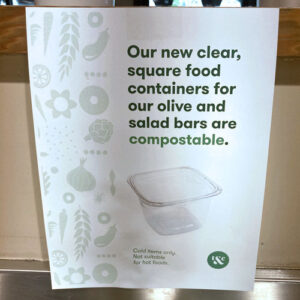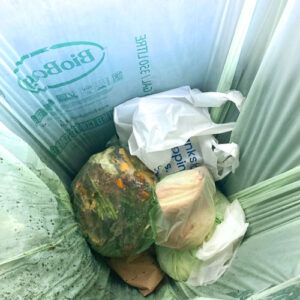Top: Image shows the polylactic acid molecular structure.
 Sally Brown
Sally Brown
Bioplastic offers those who compost some hope and some caveats. Bioplastic is a broad term that refers to plastics made from organic materials other than petroleum. These materials can be engineered to produce conventional old school plastic that does not decompose. They can also be engineered to decompose. Petroleum based plastic can also be designed to decompose. Decomposition is not based solely on the initial feedstock but primarily on the structure of the polymers (Albertsson and Hakkarainen, 2017).
How well they decompose depends. It is a factor of what environment you are counting on them to decompose in and how much time you have on your hands to wait for the decomposition to get to completion. While you may be focused on decomposition in the compost pile, not all the chemical engineers designing these materials share your focus. Some of these plastics are designed to degrade when exposed to sunlight and others begin to decompose in marine environments. In some cases, degradation means breaking apart the chains of polymers that make up the plastic and not whether the polymers themselves will decompose.

The majority of food service plastic does not need the longevity of conventional plastic and so is well suited to biodegradable plastics. Photos by Sally Brown
One of the nicest examples of degradation of plastics outside of the compost pile are plastics designed for medical use. Those stitches that just dissolve are one example of biomedical applications for degradable plastics. It should be noted that however well you manage your pile, conditions in it are likely to be less uniform than those in the human body.
Bioplastics Landscape
Currently only about 1% of the plastic produced is bioplastic. Another way to express that is about 4 million tons of the plastic produced falls into the category of bioplastic (Ahsan et al., 2023). Bioplastic is not always seen as a silver bullet. When made from cornstarch, for example, the concern is that using farmland to grow corn-derived plastic will take away from the capacity to grow food. If all global packaging plastic came from corn, that would require over 50% of all the corn currently grown (Rosenboom et al., 2022). No more grits for you.
Bioplastic can also be more energy intensive to produce than fossil based plastics. Unless they are actually composted, these materials may end up in the landfill just like the old fashioned stuff. This suggests that they may not be the key to a circular economy for plastics that many of us fantasize about (Rosenboom et al., 2022). Estimates have suggested that replacing all the fossil fuel based-plastic with sugar cane-based plastic would have the same carbon impact as simply recycling the plastic that is conventionally produced (25% emissions reduction). A bigger bang for the carbon would be to use renewable energy in plastic production (62%). Carbon impact is one thing, swimming in a sea of PVC is another.

Currently only about 1% of the plastic produced is bioplastic.
The same way that there are many types of conventional plastic, there are also many types of bioplastic. When these materials are being designed, their ability to do the job as well as traditional plastics is likely the primary concern. Bioplastic soup spoons that are not heat tolerant may be great for gazpacho but you need something that also works for chicken noodle. To my knowledge, they are not engineered with a compost pile in mind. Nevertheless, composting is often considered the most efficient way for them to decompose (Ahsan et al., 2023). Polybutylene adipate terephthalate (PBAT) is one of the most common types, comprising close to 20% of the market (Wang et al., 2024). Put it in soil and come back in 100 days and about 7% of it will be gone. Add it to water and come back in three months you’ll find 90% remaining. Put it in a hot compost pile and 90% of it will disappear, at least according to the peer review literature.
In the broad world, there are standards to measure compostability. ASTM has defined compostable polymers (groups of monomers that make up plastic) as compostable if 90% of their carbon converts to carbon dioxide (D5338). Closer to home we have the BPI certification of compostability. Decomposition can involve breaking into smaller pieces, chemical alteration and finally, edibility. In many cases specific enzymes are required to get this process going.
The Ingredients
If you are thinking about making some bioplastics, there are certain ingredients to have on your shopping list (Ahsan et al., 2023):
- Lactic acid is the main ingredient in polylactic acid (PLA) and sugar is the building block for lactic acid. The literature says that PLA degrades in a compost pile within three weeks. In high temperature piles it breaks into smaller pieces and then the lactic acid parts are consumed.
- Starch-based bioplastics are cheap to produce and supposedly degrade quickly. Time required to make this stuff disappear is within normal limits for composting. Time frames for 90% decomposition range from 20 days to 9 weeks.
- PHAs are type of bioplastic produced from microalgae. This is a new and up and coming feedstock — currently limited by high production costs. Studies have shown that in hot piles for up to 15 days, up to 67% of the material decomposes. Just a wee bit more time than what is required for PFRP (Process to further reduce pathogens) compliance. Enzymes helped this process along a bit. Certain varieties appear to do better but more work is needed.
- Cellulose is good for wood and good for plastic. One paper praised cellulose for its “strength, stiffness, high durability and biodegradability” and then went on to say that a problem with it is its lower mechanical properties, including strength and flexibility. Seems like there are still some kinks to work out with this one. Supposedly though, this material composts quickly. However, one of the studies tested cellulose powder rather than cellulose dinner plates.
Note that while some publications report compostability based on the ingredient list for the bioplastics, others point out that it is the chemical structure of the finished product that is the critical factor in determining how quickly it can decompose (Albertsson and Hakkarainen, 2017). Some manufacturers have added special ingredients to help these bioplastics start to break apart. For example, pro-oxidants help to break initial bonds that microbes just can’t sink their teeth into. These are marketed as pro-oxidant additive containing or PAC plastics — which just means that the process can start relatively quickly. It has no bearing on how long the process will actually take. In addition, these additives are not always environmentally friendly.
It is also important to understand the conflict between wanting a product that is sturdy and has a long shelf life (aka plastic) and one that decomposes quickly. For the compost industry, food packaging products are less likely to require a long shelf life than construction materials or fabrics. The majority of food service plastic does not need the longevity of conventional plastic and so is well suited to biodegradable plastics. There is just so long you’ll want to hold onto that take-out container.
A question then arises if there is sufficient demand for these bioplastic materials to have them manufactured on a large scale. In other words, large enough to displace conventional plastics, large enough so that they don’t automatically get screened out of a pile. That begs the next big question: Is the composting industry definition of compostable at all compatible with the bioplastic manufacturers’ definition?
Sally Brown, BioCycle Senior Adviser, is a Research Professor at the University of Washington in the College of the Environment.













